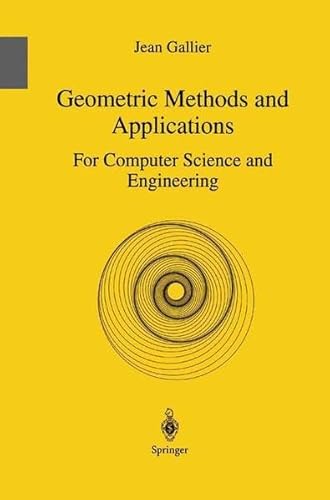Sinopsis
1 Introduction.- 1.1 Geometries: Their Origin, Their Uses.- 1.2 Prerequisit es and Notation.- 2 Basics of Affine Geometry.- 2.1 Affine Spaces.- 2.2 Examples of Affine Spaces.- 2.3 Chasles's Identity.- 2.4 Affine Combinations, Barycenters.- 2.5 Affine Subspaces.- 2.6 Affine Independence and Affine Frames.- 2.7 Affine Maps.- 2.8 Affine Groups.- 2.9 Affine Geometry: A Glimpse.- 2.10 Affine Hyperplanes.- 2.11 Intersection of Affine Spaces.- 2.12 Problems.- 3 Properties of Convex Sets: A Glimpse.- 3.1 Convex Sets.- 3.2 Carathéodory's Theorem.- 3.3 Radon's and Helly's Theorems.- 3.4 Problems.- 4 Embedding an Affine Space in a Vector Space.- 4.1 The "Hat Construction," or Homogenizing.- 4.2 Affine Frames of E and Bases of Ê.- 4.3 Another Construction of Ê.- 4.4 Extending Affine Maps to Linear Maps.- 4.5 Problems.- 5 Basics of Projective Geometry.- 5.1 Why Projective Spaces?.- 5.2 Projective Spaces.- 5.3 Projective Subspaces.- 5.4 Projective Frames.- 5.5 Projective Maps.- 5.6 Projective Completion of an Affine Space, Affine Patches.- 5.7 Making Good Use of Hyperplanes at Infinity.- 5.8 The Cross-Ratio.- 5.9 Duality in Projective Geometry.- 5.10 Cross-Ratios of Hyperplanes.- 5.11 Complexification of a Real Projective Space.- 5.12 Similarity Structures on a Projective Space.- 5.13 Some Applications of Projective Geometry.- 5.14 Problems.- 6 Basics of Euclidean Geometry.- 6.1 Inner Products, Euclidean Spaces.- 6.2 Orthogonality, Duality, Adjoint of a Linear Map.- 6.3 Linear Isometries (Orthogonal Transformations).- 6.4 The Orthogonal Group, Orthogonal Matrices.- 6.5 QR-Decomposition for Invertible Matrices.- 6.6 Some Applications of Euclidean Geometry.- 6.7 Problems.- 7 The Cartan-Dieudonné Theorem.- 7.1 Orthogonal Reflections.- 7.2 The Cartan-Dieudonné Theorem for Linear Isometries.- 7.3 QR-Decomposition Using Householder Matrices.- 7.4 Affine Isometries (Rigid Motions).- 7.5 Fixed Points of Affine Maps.- 7.6 Affine Isometries and Fixed Points.- 7.7 The Cartan-Dieudonné Theorem for Affine Isometries.- 7.8 Orientations of a Euclidean Space, Angles.- 7.9 Volume Forms, Cross Products.- 7.10 Problems.- 8 The Quaternions and the Spaces S3, SU(2), SO(3), and ?P3.- 8.1 The Algebra ? of Quaternions.- 8.2 Quaternions and Rotations in SO(3).- 8.3 Quaternions and Rotations in SO(4).- 8.4 Applications of Euclidean Geometry to Motion Interpolation.- 8.5 Problems.- 9 Dirichlet-Voronoi Diagrams and Delaunay Triangulations.- 9.1 Dirichlet-Voronoi Diagrams.- 9.2 Simplicial Complexes and Triangulations.- 9.3 Delaunay Triangulations.- 9.4 Delaunay Triangulations and Convex Hulls.- 9.5 Applications of Voronoi Diagrams and Delaunay Triangulations.- 9.6 Problems.- 10 Basics of Hermitian Geometry.- 10.1 Sesquilinear and Hermitian Forms, Pre-Hilbert Spaces and Hermitian Spaces.- 10.2 Orthogonality, Duality, Adjoint of a Linear Map.- 10.3 Linear Isometries (Also Called Unitary Transformations).- 10.4 The Unitary Group, Unitary Matrices.- 10.5 Problems.- 11 Spectral Theorems in Euclidean and Hermitian Spaces.- 11.1 Introduction: What's with Lie Groups and Lie Algebras?.- 11.2 Normal Linear Maps.- 11.3 Self-Adjoint, Skew Self-Adjoint, and Orthogonal Linear Maps.- 11.4 Normal, Symmetric, Skew Symmetric, Orthogonal, Hermitian, Skew Hermitian, and Unitary Matrices.- 11.5 Problems.- 12 Singular Value Decomposition (SVD) and Polar Form.- 12.1 Polar Form.- 12.2 Singular Value Decomposition (SVD).- 12.3 Problems.- 13 Applications of Euclidean Geometry to Various Optimization Problems.- 13.1 Applications of the SVD and QR-Decomposition to Least Squares Problems.- 13.2 Minimization of Quadratic Functions Using Lagrange Multipliers.- 13.3 Problems.- 14 Basics of Classical Lie Groups: The Exponential Map, Lie Groups, and Lie Algebras.- 14.1 The Exponential Map.- 14.2 The Lie Groups GL(n, ?), SL(n, ?), O(n), SO(n), the Lie Algebras gl(n, ?), sl(n, ?), o(n), so(n), and the Exponential Map.- 14.3 Symmetric Matrices, Symmetric Positive Definite Matrices, and the Expo
Críticas
From the reviews: SIAM REVIEW "The treatment of each topic is in depth and to the point. It is a rigorous theorem-proof approach on the one hand, but there are plenty of comments and remarks that make for easier reading. The level of the book, if intended for engineers and computer scientists, is advance graduate...The style of the book is often refreshingly informal but never lacks rigor and precision. Each chapter has a copious section of problems. These are not just simple questions such as ‘prove theorem xy,’ but are thorough investigations of subtopics, in a way that will certainly motivate a student’s desire to explore that topic further...I am a mathematician embedded in a computer science environment, and I will certainly study some of the chapters in this book in more depth." MATHEMATICAL REVIEWS "The presentation of the material is mathematically rigorous, including precise definitions and proofs for almost all results...Gallier’s book will be a useful source for anyone interested in applications of geometrical methods to solve problems that arise in various branches of engineering. It may help to develop the sophisticated concepts from the more advanced parts of geometry into useful tools for applications."
"Sobre este título" puede pertenecer a otra edición de este libro.
